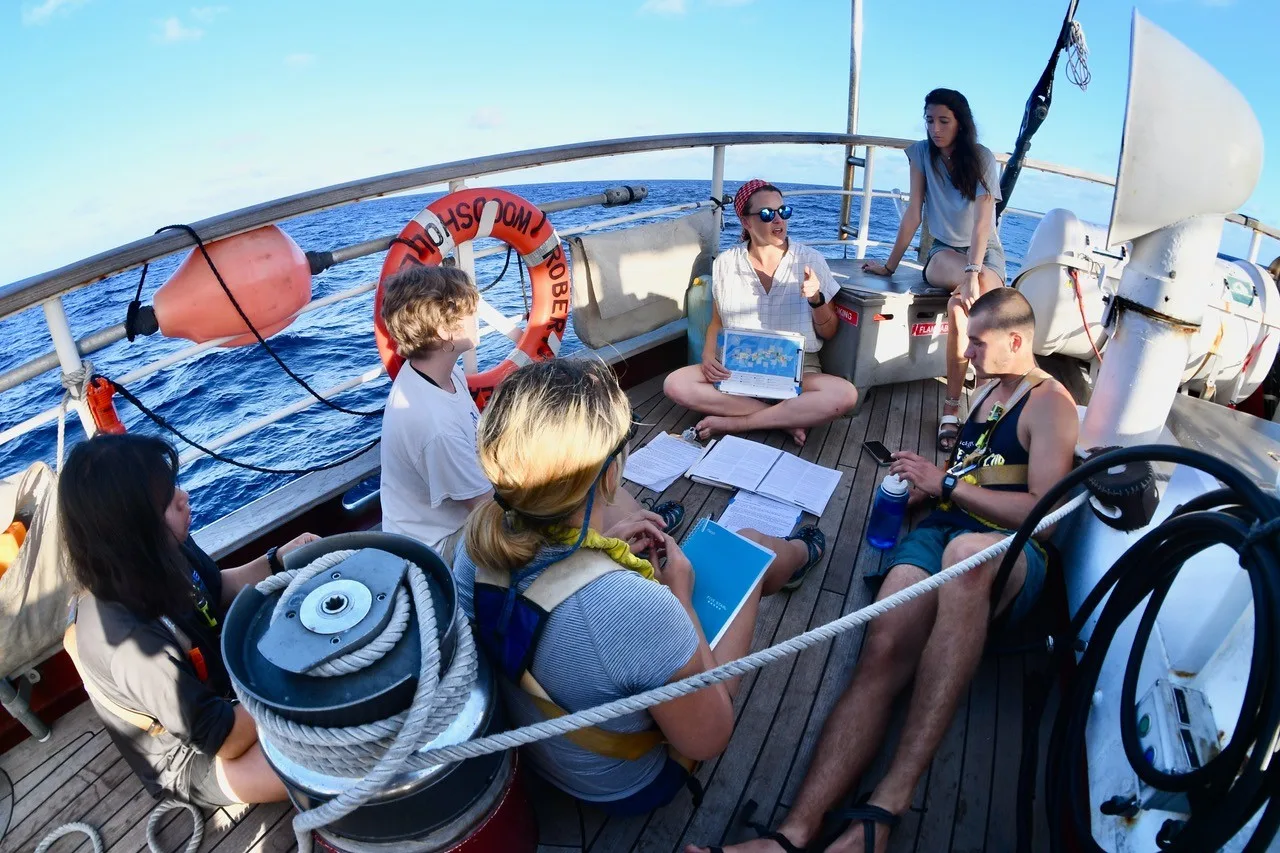Programs Blog
No Better Classroom

July 3, 2025
Time: 20:12
Location: 07°13.772N,143°56.534W
Weather: Humid, partly cloudy
People often ask me, “How different is teaching at SEA from your regular classroom?” Unlike Prof. Witting, who has over 2 decades of teaching experience at sea, I’m a visiting professor from the University of Rhode Island. This is my second summer teaching for SEA on the Robert C. Seamans. So many things are different – I can’t rely on slides, and the whiteboards are small. My usual blazer look is impossible in the heat. It can be challenging to navigate the personal/professional divide – how do you give critical feedback to the student who is going to wake you up at 6am? You never know when a bird is going to catch a flying fish, or dolphins appear, in the middle of your lecture.
But not all differences are challenges. SEA students are different. It’s probably a combination of self-selection, what the program demands, and how the program helps students grow. It might be in part that I just get to know students better, as whole people. But they are tough, and curious, and resourceful. They ask questions and venture answers at higher rates than I’m used to. They take note diligently despite the lack of desks, and the constant movements (pitches and rolls) of the quarterdeck-classroom. They are always prepared to discuss the readings. They bring their own ideas and experiences to class. To the parents who are reading this: good job, and thank you. I can’t imagine the pride you must feel.
But one of the best differences, for me, is the location. My last two lectures have focused on the ‘Areas Beyond National Jurisdiction.’ That’s where we are now, a place most people never go. I’m writing this blog on top of 5150 meters of water, and at the bottom is the ‘Clarion Clipperton Zone.’ This is a part of the ocean controlled by the International Seabed Authority, where exploratory seabed mining has been happening for 20 years, and where commercial-scale mining might begin as soon as next year. Do a quick google for “ISA” and/or “Clarion Clipperton Zone” (CCZ) and you’ll see that seabed mining is the topic of heated international debate, and we are at a critical moment in deciding whether or not to mine. Below the Seamans right now is ‘APEI-7,’ one of 13 ‘Areas of Particular Environmental Interest’ where seabed mining is banned. (Is this an MPA? Emmy and Claire, with help from Bethany, are going to tell us in their research project presentation). Tomorrow we may cross above a Chinese exploration plot, and then perhaps a Japanese one (…I’m not in charge of navigation). I am thrilled.
You can’t beat being there. I’ve taught about this zone for almost a decade, and it has always been abstract. Now I can follow the depth contours in the science lab. Before I had a chance to announce our entry to the “CCZ,” student Isaiah asked “Beth, are we in the CCZ? I saw we passed the Clipperton Fracture zone on the chart plotter.” Not only are we here, we’re all here together.
Sending love to my family in Kansas, especially my niblings Coen, Alex, Kitty, and Jimmy, and to my dad in Michigan, all of whom follow our progress on their personal globes. And to the man I think about every morning on lookout, and every night at the helm, Mike.
Recent Posts from the Ships
- Ocean Classroom 2024-A collaborative high school program with Proctor Academy
- Collaborations and Long-term Commitments: SEA’s Caribbean Reef Program Sets a Course for Coastal Programs that Compliment Shipboard Experiences.
- Sea Education Association students prepare for life underway using state of the art nautical simulation from Wartsila Corporation.
- SEA Writer 2022, Magazines From the Summer SEA Quest Students
- Technology@SEA: Upgrades Allow Insight into Ocean Depths
Programs
- Gap Year
- Ocean Exploration
- High School
- Science at SEA
- SEA Expedition
- SEAScape
- Pre-College
- Proctor Ocean Classroom
- Protecting the Phoenix Islands
- SPICE
- Stanford@SEA
- Undergraduate
- Climate and Society
- Climate Change and Coastal Resilience
- Coral Reef Conservation
- Marine Biodiversity and Conservation
- MBL
- Ocean Exploration: Plastics
- Ocean Policy: Marine Protected Areas
- Oceans and Climate
- Pacific Reef Expedition
- The Global Ocean: Hawai'i
- The Global Ocean: New Zealand